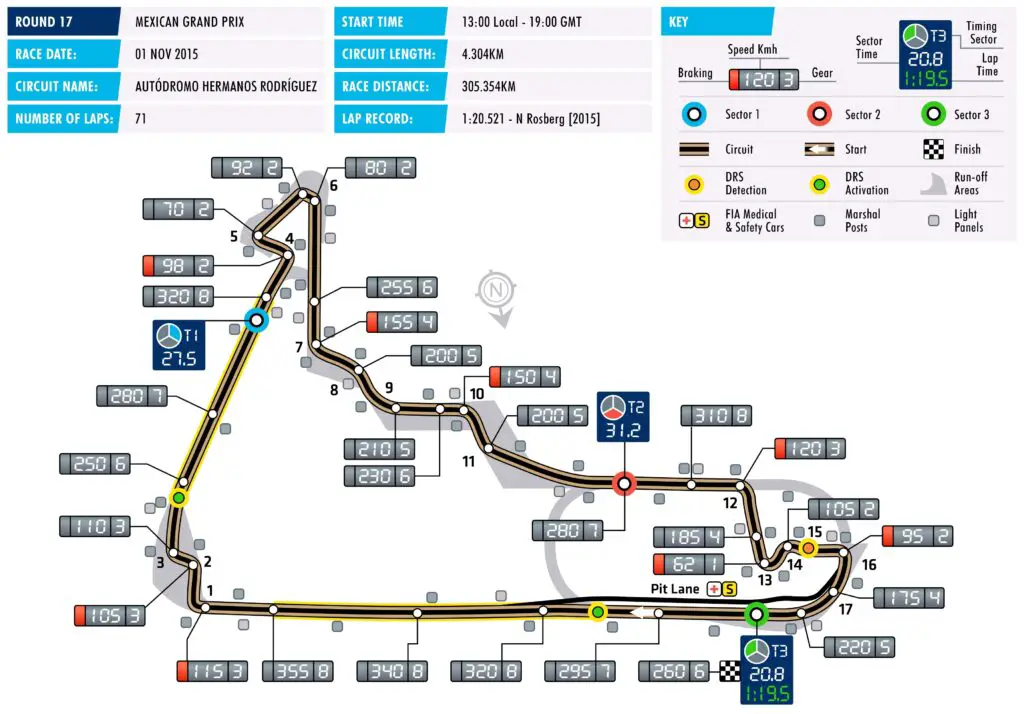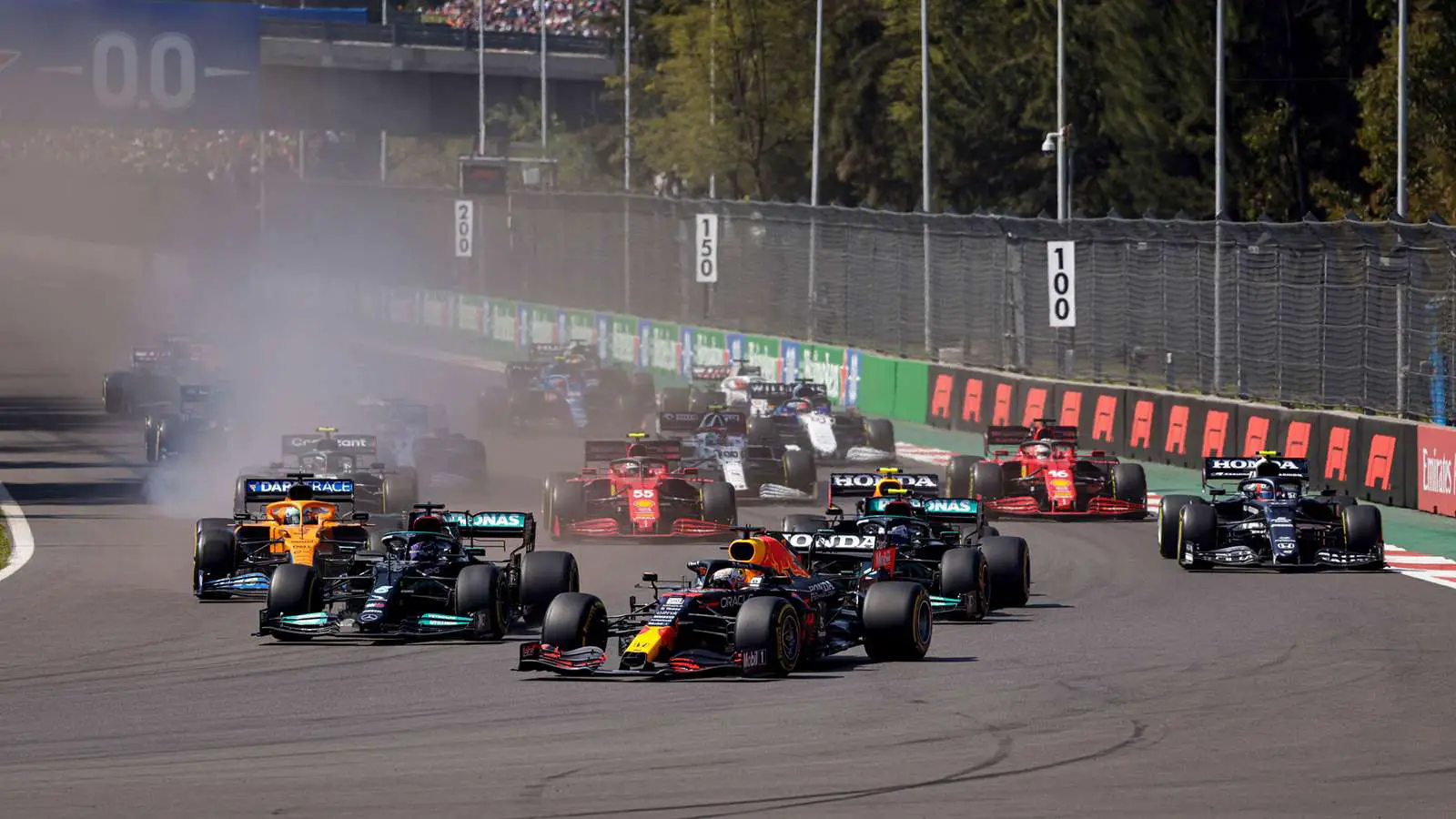The Mexican GP is one of the most exciting and challenging races on the Formula 1 calendar. Held at the Autodromo Hermanos Rodriguez in Mexico City, the circuit combines high altitude, fast straights, tight corners.
It also has a unique stadium section that creates a spectacular atmosphere for both drivers and fans. Here is a brief overview of the circuit layout and its main features.
History and location
The circuit was built in 1959 within a public park. It is named after Mexico’s famous racing brothers Ricardo and Pedro Rodriguez, who both competed in F1 in the 1960s.
The track hosted its first official F1 race in 1963, won by Jim Clark. It became the traditional season finale for several years. However, problems with crowd control and safety standards led to its removal from the calendar in 1970.
It returned in 1986 with a revamped layout that included a chicane. This was intended to slow down the cars before the fearsome banked Peraltada corner. The circuit was dropped again in 1992 due to its bumpy surface and outdated facilities.
After a 23-year absence, F1 came back to Mexico in 2015. A major overhaul was carried out on the circuit that preserved most of its original outline. However, it did replace the Peraltada with a complex of corners that runs through the old Foro Sol baseball stadium.
This allowed thousands of fans to watch the action up close. The circuit also received new asphalt, run-off areas, grandstands and paddock buildings to meet modern standards.
The Mexican GP has since become one of the most popular and festive events on the F1 schedule. It attracts huge crowds and producing thrilling races.
Mexican GP – Track characteristics
The Autodromo Hermanos Rodriguez is located over 2 km above sea level. This makes it the highest circuit on the F1 calendar. The air is thinner and less oxygenated, reducing the engine power and downforce of the cars. It also affects the cooling systems and tire performance.
The track is also one of the fastest in F1. The average speed is over 200 km/h and a top speed of over 360 km/h on the long main straight.
The circuit has a total length of 4.304 km and consists of 17 turns. It includes a mix of slow and medium-speed corners that challenge the drivers’ braking, traction and tire management skills.
The most iconic feature of the circuit is the stadium section. Cars enter through a tight left-right chicane (Turns 12 and 13). The cars then accelerate into a fast right-hander (Turn 14) that leads them into the Foro Sol.
There, they negotiate two more slow corners (Turns 15 and 16) under the roar of the crowd. They then exit onto another straight that takes them to the final corner (Turn 17). This is a sharp left-hander that rejoins the main straight.
The stadium section is also where the podium ceremony takes place, creating an unforgettable spectacle for both drivers and fans.
The current lap record at the Autodromo Hermanos Rodriguez is 1:17.774, set by Valtteri Bottas in 2021.
The most successful driver at the circuit is Jim Clark. He won twice in 1963 and 1967, while Mercedes is the most successful constructor with four wins since 2015.
The Mexican GP – Track Layout

The circuit is named after Mexico’s famous racing brothers, Ricardo and Pedro Rodríguez. They were pioneers of the sport in their country.
Ricardo tragically died in a practice accident at the track in 1962. Pedro was killed in an endurance race in Germany in 1971.
The circuit hosted its first official F1 race in 1963 and became a regular fixture until 1970. After a 16-year hiatus, it returned in 1986 and stayed until 1992.
It then disappeared again until 2015, when it underwent a major renovation to bring it up to modern standards.
The Mexican GP Layout
The Autódromo Hermanos Rodríguez is a fast and challenging circuit that tests the skills and courage of the F1 drivers. The track has 17 turns and a lap length of 4.304 km (2.674 mi). The average speed is over 200 km/h (124 mph).
A huge challenge of the circuit is its altitude. The track is located over 2 km (1.2 mi) above sea level. It means the air is thinner and less oxygenated.
This affects both the performance and cooling of the engines, as well as the aerodynamics and grip of the cars. The drivers also have to cope with less oxygen in their bodies. It can make them feel more tired and less focused.
To compensate for these effects, the teams have to run more wing and engine power than usual. The drivers have to stay hydrated and well-rested.
The circuit also has one of the longest straights in F1. It is 1.2 km (0.75 mi) from Turn 3 to Turn 4. This is where the cars reach their top speeds of over 360 km/h (224 mph). Drivers can use their DRS (Drag Reduction System) to overtake their rivals.
Mexican GP – Turns 1 to 4
The lap starts with a short run to Turn 1, a tight right-hander that requires heavy braking and good traction.
The drivers have to avoid locking up their tires and hitting the inside kerbs, as they prepare for Turn 2.
This is a left-hander that leads into Turn 3, a long right-hander that opens up onto the main straight.
There is a DRS detection zone at the start of the straight. This is where the drivers can use their DRS (Drag Reduction System) to gain speed and overtake their rivals.
The main straight is one of the longest in F1, measuring 1.2 km (0.75 mi), and the drivers reach speeds of over 360 km/h (224 mph).
They have to brake hard for Turn 4. This is a sharp right-hander that leads into a technical section of medium speed corners.
Mexican GP – Turns 5 – 11

The F1 drivers have to balance their speed and grip, as they navigate Turns 5 to 11, which include changes of direction, elevation, and camber. The track surface is also bumpy and slippery, making it easy to lose control or damage the tires.
The drivers then exit Turn 11 and accelerate towards Turn 12. This is where they enter the most distinctive feature of the circuit: the Foro Sol.
This is a former baseball stadium that now hosts the final complex of corners and the podium ceremony.
Mexican GP – Turns 12 – 17

The drivers enter the stadium at high speed, before slowing down for Turns 13 to 16. These ate a series of tight bends that test their traction and balance.
The fans in the grandstands create a deafening roar as they cheer on their heroes, especially the local favorite Sergio Pérez.
The drivers then exit Turn 16 and face the final challenge of the lap: Turn 17, also known as the Peraltada, a fearsome banked curve that was once considered too dangerous for F1 cars.
The drivers have to carry as much speed as possible through this corner, while avoiding running wide onto the grass or hitting the wall.
The exit is crucial, as it determines their speed on the start/finish straight and their lap time.
The Mexican GP circuit layout is a mix of speed, spectacle, and skill that makes it one of the most exciting and demanding tracks on the F1 calendar. The drivers have to master its unique characteristics and challenges, while the fans have to enjoy its festive and passionate atmosphere. It is a race that no one wants to miss.

